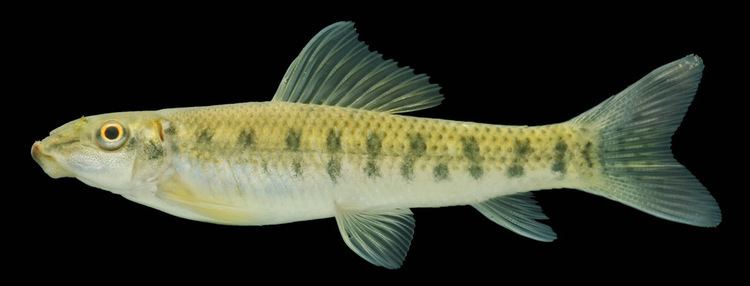Genus Gyrinocheilus Higher classification Gyrinocheilus | Phylum Chordata Family Gyrinocheilidae Scientific name Gyrinocheilus aymonieri Rank Species | |
 | ||
Similar Gyrinocheilus, Siamese algae eater, Crossocheilus, Flying fox, Epalzeorhynchos | ||
Gyrinocheilus aymonieri gold chinese algae eater
Gyrinocheilus aymonieri is a freshwater fish native to large parts of Southeast Asia. It is of interest as a local food source and for the aquarium trade. Its common names include honey sucker, sucking loach, Siamese algae eater, and Chinese algae eater; the FAO-endorsed common name is Siamese algae-eater.
Contents
- Gyrinocheilus aymonieri gold chinese algae eater
- Chinese algae eater gyrinocheilus aymonieri
- Physical description
- In aquaria
- References
G. aymonieri is found in the Chao Phraya basin, northern Malay Peninsula, Mekong basin (in Cambodia, Yunnan province in China, Laos, Thailand, and Vietnam), Mae Klong basin and the Xe Bang Fai River. It is most often seen in large rivers, occasionally entering flooded fields. The fish spends most of its time on flat surfaces, such as rocks, in flowing water, using its unusually formed inferior mouth to attach itself to rocks in stronger flows.
The fish are sold in local markets as a food source and small fish are used in preparation of prahok.

Chinese algae eater gyrinocheilus aymonieri
Physical description

G. aymonieri has been recorded as reaching at least 28 cm (11 in) SL and is the only species in the genus to have 9 branched dorsal rays and 36–40 lateral line scales. The mouth is inferior with a special "sucker" modification which allows the fish to attach itself to smooth surfaces. No barbels are present.

Wild type colour varies from pale grey to olive, with darker markings along the lateral line which vary from a solid stripe with alternating higher and lower extensions to uneven dots. The belly is usually paler than the base colour. Some darker markings may also be observed along the back and on the caudal fin, but no dark markings occur on the pelvic and anal fins.
In aquaria

G. aymonieri is similar in colouration to a number of other species which are commonly available in the aquarium trade, such as Crossocheilus oblongus, Epalzeorhynchos kalopterus, and Garra cambodgiensis, and is sometimes misidentified as one of these species. It is available in a number of colour morphs, including wild type, gold, marble, albino, and leucistic forms.
The species does not breed readily in home aquaria, although fry are occasionally reported as being found in overgrown aquaria. At this time, no definitive spawning triggers are known. Sexing is difficult, although mature males may develop breeding tubercles on their noses, while females become plumper.
G. aymonieri fish are often bought as algae eaters because they will readily eat algae when young, but with age, their preference changes towards meatier foods, such as prepared aquarium foods, frozen crustaceans and small fish. This change is also reflected in behaviour, which becomes aggressive with age, especially so towards others of their own kind and fish with similar colors.
The other species in the genus, Gyrinocheilus pennocki and the Gyrinocheilus pustulosus, are rarely seen in the aquarium trade.
For algae control in the aquarium, the similar Siamese Algae Eater is a much better fish - a true algae eater without the bad habits of the Chinese Algae Eater. The Bistlenose pleco is also an excellent algae eater. For the reasons listed above, the Chinese Algae Eater should be avoided. However, it is a staple of the aquarium industry, and it is heavily promoted. Getting one of these 'algae eaters' is a common beginner's mistake.
